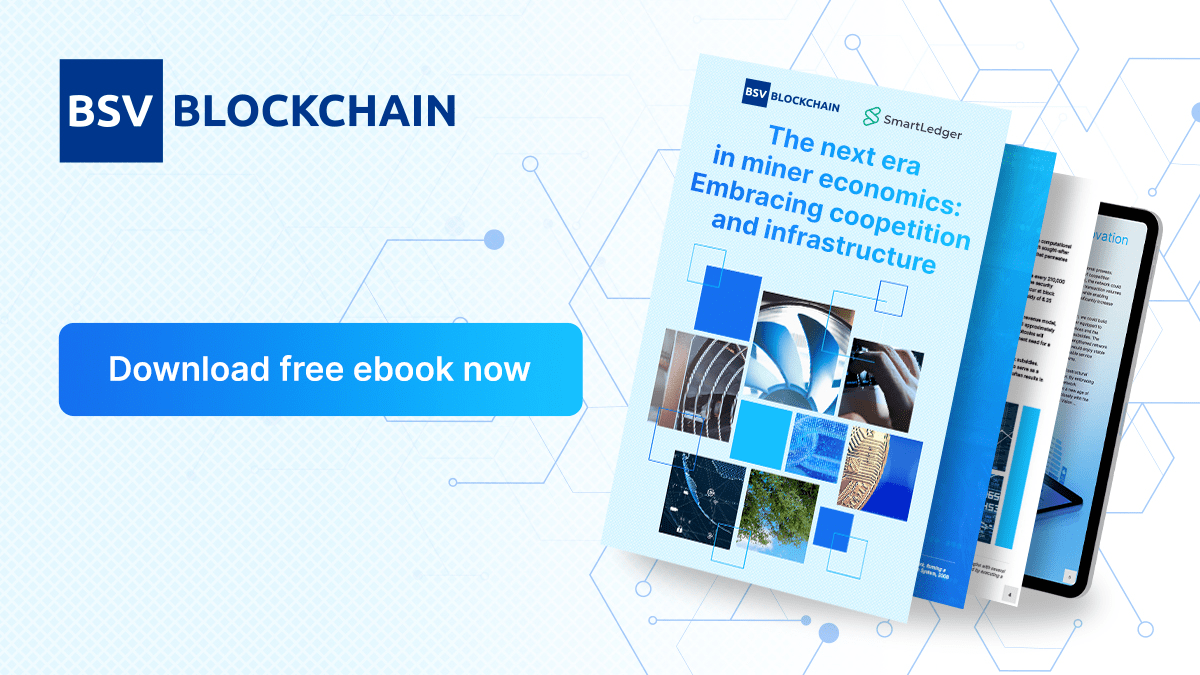As blockchain technology continues to evolve and mature, it has become increasingly important that we need to broaden our viewpoint beyond mere competition. The future demands a more sophisticated paradigm in which competition and cooperation are not separate entities, but instead interwoven to give rise to a concept known as ‘coopetition.’
The role of infrastructural innovation in the new age of mining is unpacked in more detail in the new eBook – The next era in miner economics: Embracing coopetition and infrastructure.

The ebook was written by Bryan Daugherty (Global Public Policy Director at BSV Association), Gregory Ward ( Chief Development Officer at SmartLedger), and Kurt Wuckert Jr (Chief Bitcoin Historian at Coingeek).
The second chapter of the eBook focuses on how this notion of coopetition carries the substantial transformative potential for the mining sector, presenting fresh opportunities for mutual gains while still harnessing the driving energy of competition.
A balancing act: profitability now and in future
While the current emphasis on enhancing node software and computational capabilities remains crucial, it is equally vital for miners to allocate resources to bolster their network infrastructure. The efficiency of block propagation, heavily reliant on network strength and speed, becomes pivotal, especially in blockchains accommodating larger block sizes like BSV.
Shifting this focus not only improves network efficiency but also establishes the essential connectivity needed for high transactional throughput. This shift ensures that miners’ success is not solely contingent on their computational prowess. By fostering an environment of coopetition, a harmonious blend of competition and cooperation, the network can effectively handle the soaring demand for transactions while providing miners with opportunities to significantly increase their revenue.
Furthermore, through coopetition, we can construct a resilient network better equipped to navigate fluctuations in token prices and the inevitable reduction in block subsidies. The primary beneficiaries of this fortified network would be end users, who can relish stable microtransaction fees and reliable services irrespective of market dynamics.
In sum, the time is ripe for innovative infrastructure development within the mining sector. By embracing coopetition and investing in network infrastructure, we can usher in a new era of mining that closely aligns with the core principles of Satoshi’s Vision.
Centralisation vs. protocol control
When discussing PoW (proof-of-work) networks, it’s essential to grasp the differentiation between the roles of miners and those responsible for protocol maintenance and development. There exists a widespread misconception that miners wield centralising power. In reality, it’s the developers and protocol maintainers who possess substantial influence and have the potential to establish centralised control.
Miners, by the inherent design of blockchain systems, are incapable of centralising power. Their primary functions encompass transaction validation, rule enforcement, and network security. Their scope of influence is restricted and does not encompass the capacity to modify network rules or structure.
In a decentralised system like the BSV blockchain, miners serve as enforcers of protocol rules rather than creators. They undertake the necessary tasks to maintain the network and validate transactions but lack the authority to unilaterally alter protocol rules.
In contrast, developers and protocol maintainers wield a distinct form of power: the ability to influence or modify network rules and structure. This power, often misunderstood or overlooked, constitutes what we refer to as ‘protocol control.’ When this control resides within a small group or a single entity, it results in concealed centralisation.
The issue escalates when the protocol is not rigid but flexible, allowing alterations at will. While this flexibility may seem benign or advantageous initially, it can lead to frequent changes that disrupt network stability and security. When unchecked, it culminates in the concentration of power among those responsible for protocol maintenance and development. Such centralisation not only contradicts the intended decentralisation of blockchain networks but, as frequently observed, may lead to potential misuse or abuse of power.
Therefore, it is imperative to acknowledge the fiduciary responsibility of developers and protocol maintainers. Their authority and influence over the network must be recognised, comprehended, and monitored to prevent inadvertent centralisation and preserve the integrity and decentralisation of the network.
